
BIOS and Overclocking …
Get fast to the right UEFI settings …
BIOS and Overclocking
UEFI BIOS Update
ASRock Z170 Extreme6 Overclocking
ASRock Z170 Extreme6 memory settings
ASRock Z170 Extreme6 voltage settings
Overclock even easier
BIOS Undervolting
Fan control
Energy consumption
BIOS and overclocking …
Let us continue with the BIOS / UEFI Setup options and the UEFI overclocking. By pressing F2 or Del during the PC boot, you get access to the UEFI Setup.
The ASRock Z170 Extreme6 UEFI BIOS has a graphical interface that allows intuitive operation with the mouse or can still be conventionally operated with a keyboard.
A great new feature for beginners is the ASRock EZ Mode – So Easy Mode, the host of important information provides a clear input side and still not seems overloaded.
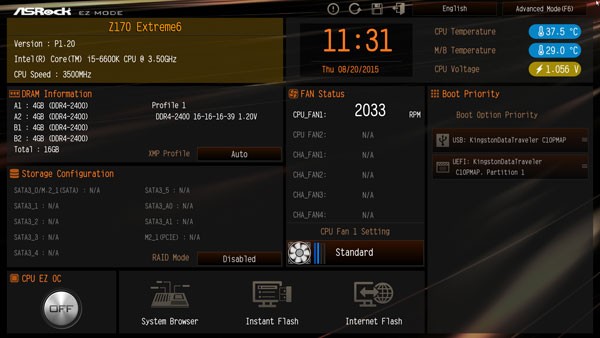
In addition to basic information such as time, date, CPU temperature, motherboard temperature, fan speeds, as well as an adjustment possibility of the fan with one click, you can see important details about the hardware.
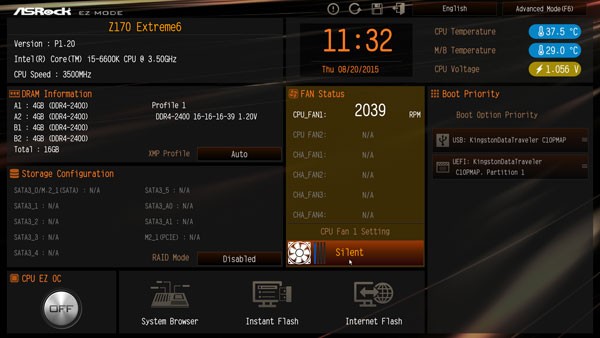
If you want to view more details about the installed hardware, there is also the System Browser view, where you can view graphically which components were installed on the mainboard.
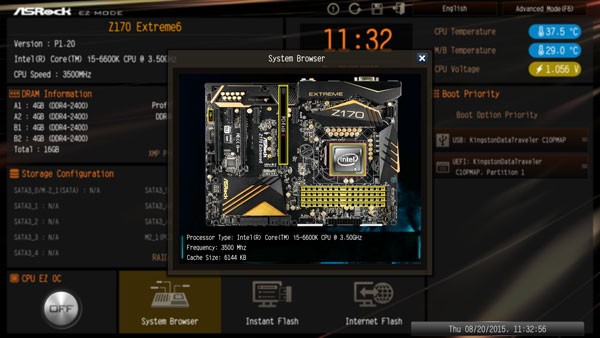
Of course you can activate many functions with keyboard shortcuts or using the F-keys and the F6 key …
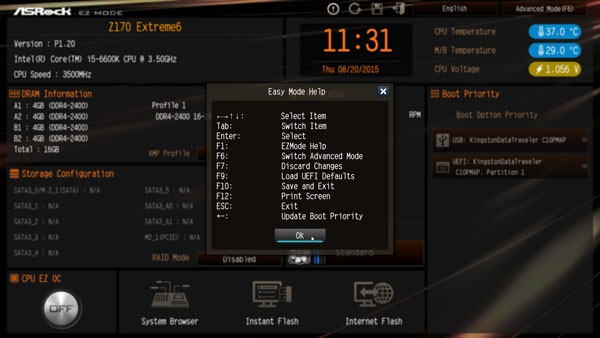
… you can get back to the ASRock advanced mode after a short confirm, which you can also set as standard option – good job, we really like that feature !
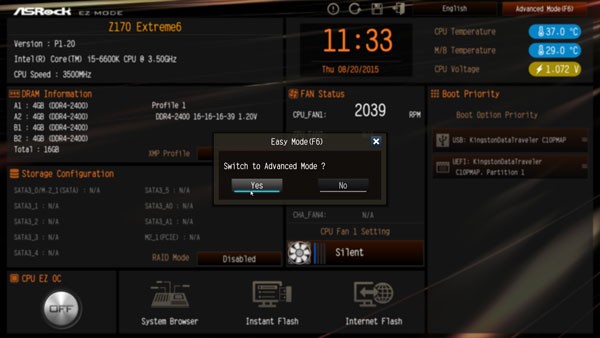
In Advanced Mode you can see at the first screen the UEFI version, the CPU used, the installed DDR4 memory with dual channel support, a language selection, the Easy Mode button and the “My Favorite” menu item.
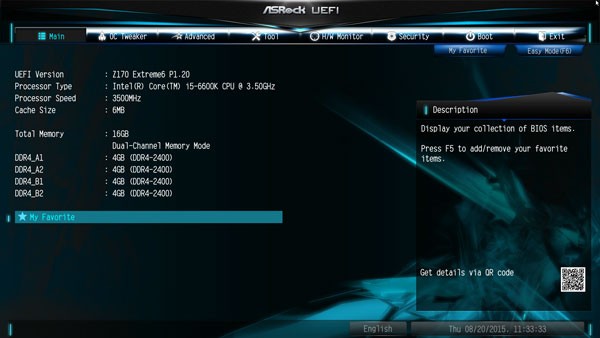
This new “My Favorite” function is very useful, because you can put here often needed menu items, to make them comfortable to see on a page and activate them more quickly. You can fill the page with your own “My Favorite” menu items by simply going to the relevant menu item, then pressing F5 and the function is included in the “My Favorite” summary page.
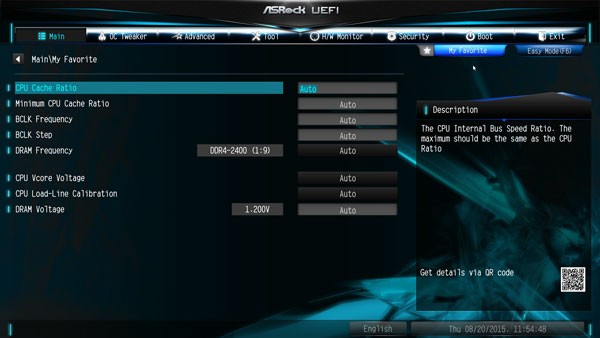
Of course, the Z170 mainboard has again the Full HD UEFI selection and the “Active Page on Entry” selection, so you can decide on which page you want to start the UEFI setup. This is useful especially when overclocking, since you have to go very often into the second OC-Tweaker menu to find the optimal OC Settings. Or you place all needed points in the “My Favorite” Overview and start then directly to the “My Favorite” page. When you own an ASRock Fatality Z170 Extreme 6 you can find the “Active Page on Entry” option and the Full HD UEFI choice under the “Advanced” menu.
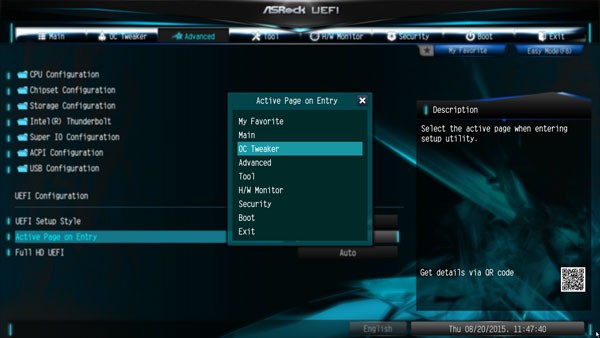
UEFI BIOS Update …
Before we begin with the UEFI settings, we first update the UEFI BIOS to the latest version.
To flash UEFI update ASRock offers some possibilities, eg the very simple Instant Flash ASRock Internet Flash or even with a direct connection to the Internet. The board is supplied with the BIOS L1.01L. The time of testing the UEFI BIOS version P1.20 was available as latest download, which we updated of course immediately.
With the so-called ASRock Instant Flash option in the tool screen or via F6 during PC start you get into the ASRock Instant Flash utility. Or you can go, as shown in the next image, over the previously mentioned EZ Mode input side to Instant Flash. Now you can simply flash a previously downloaded ASRock BIOS without a boot CD or similar by simply starting the ASRock Instant Flash utility. Just select the BIOS Flash ROM from the desired drive, such as a USB stick and even without a boot medium it is flashed and available after a restart.
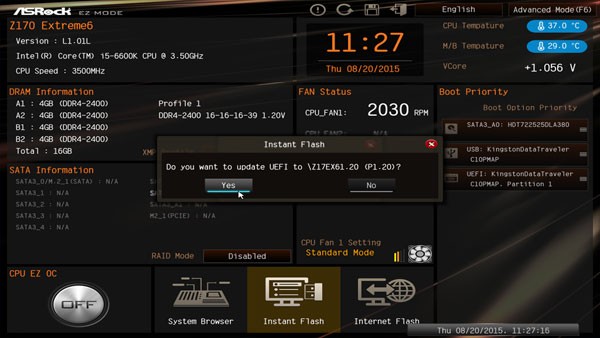
Furthermore, this motherboard is equipped with a backup BIOS, that can be updated on the tool screen by the “Secure Backup UEFI” option with a working BIOS from the other BIOS EEPROM and can be selected at any time through the BIOS Selection Switch.
If you need technical UEFI support, you can now even contact the ASRock tech service over the UEFI setup and a network connection.
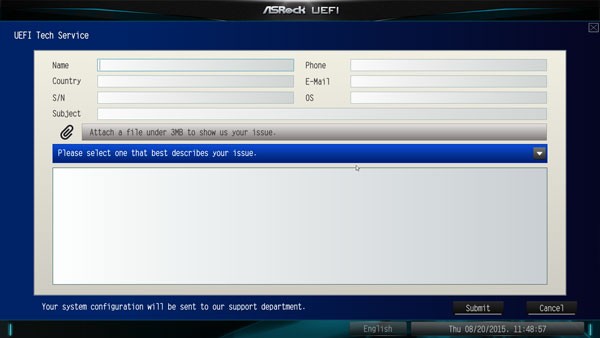
On the tool page you can also find he ASRock system browser with the details of the latest hardware, which could, in our view, also be represented as a thumbnail view in the startup menu.
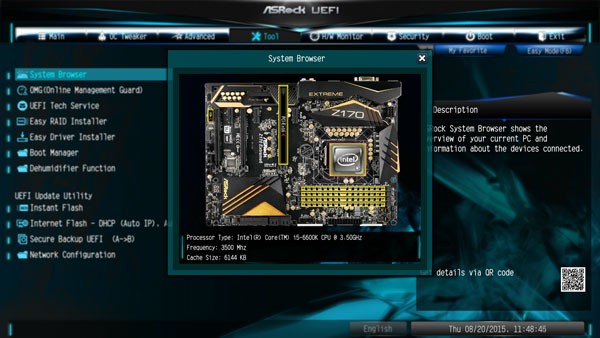
In addition, there is still the OMG – Online Management Guard, with which you can define the times and days for the Internet access. This is for example useful for parents who like to specify a fixed Internet time for their children and want to block access with a password secure in UEFI BIOS, or for companies that allow Internet access for their employees only during lunch or after regular working hours.
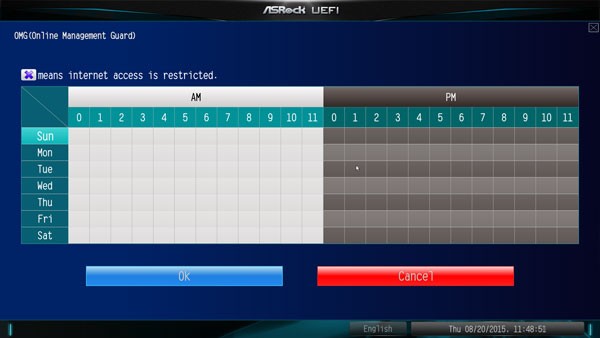
ASRock Z170 Extreme6 overclocking …
In the Z170 Extreme6 UEFI setup, there are numerous overclocking options for LGA1151 Intel CPU.
ASRock provides in UEFI setup a clearly arranged OC Tweaker menu. Here are a few of the many OC Tweaker settings in CPU Configuration:
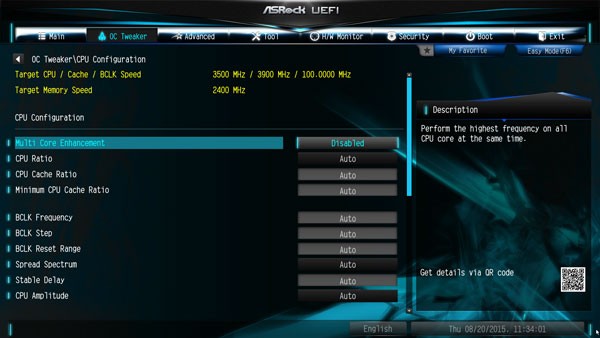
New on Intel’s Skylake is the separation of the DMI bus of the Base Clock – short BCLK. By separating the PCIe and DMI from BCLK higher BLCK values are possible, at least when the memory permits this.
The BCLK / PCIE Frequency may be adjusted in this ASRock motherboard thanks to the Hyper Engine BCLK from 90 MHz to 600 MHz. From this frequency, also with an Intel LGA1151 processors there are still generated some values ??that can quickly get too high. For this reason you should raise the BCLK clock only carefully.
In our test, the board was maximally overclocked to over 320 MHz BCLK!
Tip:
A tip for ASRock A-Tuning tool. If you can not change the BCLK frequency or the CPU multiplier within the ASRock A-Tuning tool, you should first adjust the the CPU Ratio on All Core and the BCLK to 100MHz in the UEFI.
However, our memory quit the overclocking even with the smallest memory divider. But even 50 MHz BCLK increase cause a huge leverage on the CPU Clock and memory speed. We are looking forward to the first Skylake-S CPUs with locked multiplier. The Intel Skylake “K” CPU has an unlocked multiplier, so you can increase the desired CPU frequency with the CPU Multiplier. With the 6600K CPU (standard clock 3500MHz with a CPU Ratio of 35x) the ASRock Z170 Extreme6 motherboard offered a multiplier range from 8x to 120x.
Here you can see the lower part of the OC-Tweaker page:
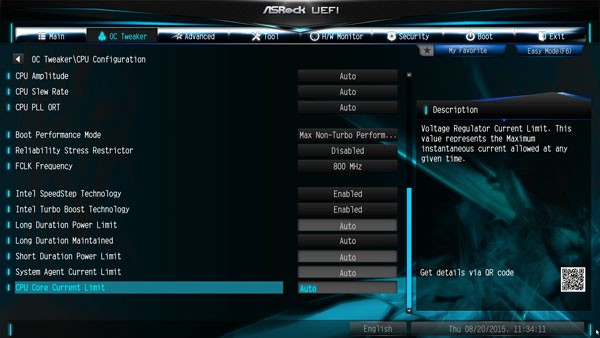
Of course that was not all, because ASRock has categorized Tweaker Settings in the following three areas: CPU Configuration, DRAM Configuration and Voltage Configuration.
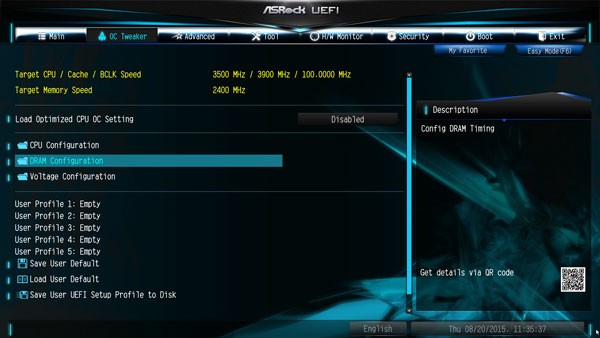
ASRock Z170 Extreme6 memory settings …
Thanks to the Load XMP support in XMP settings, the memory modules are already set correctly with one click in the UEFI BIOS. In the DRAM Configuration Menu there can be found the option to change the DDR4 reference clock to 100 MHz or 133 MHz, and how high the memory voltage to be set.
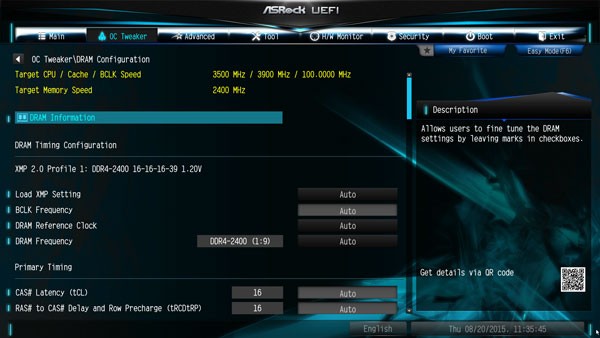
In the DDR4 memory settings you can, for example, adjust the DRAM frequency from DDR4-800 to DDR4-2666.
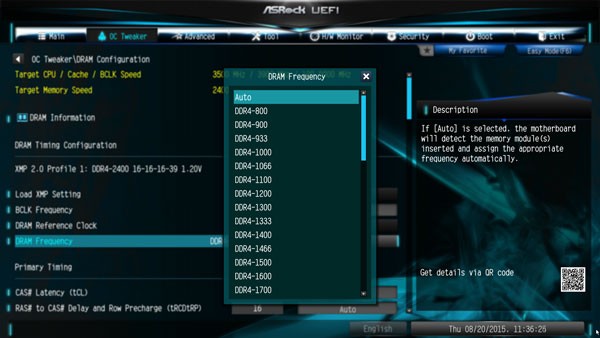
With the standard BCLK frequency of 100 MHz you can reach DDR4 frequencies up to DDR4-4133 MHz.
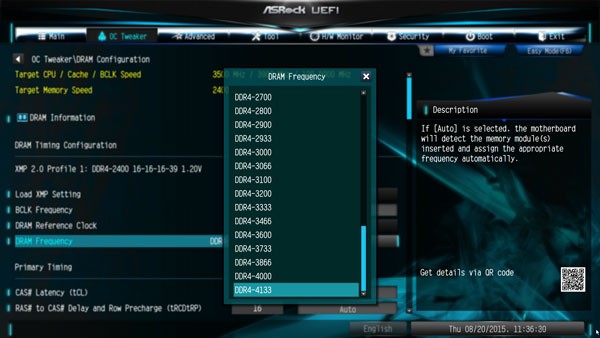
With manual BCLK raise (look at Intel OC guide) there are much more higher rates possible.
The frequency of the memory modules is immediately calculated and displayed as soon as you change the reference clock (BCLK), thus facilitating the correct frequency setting of the memory modules.
And of course you can also adjust all DDR4 timings manually:
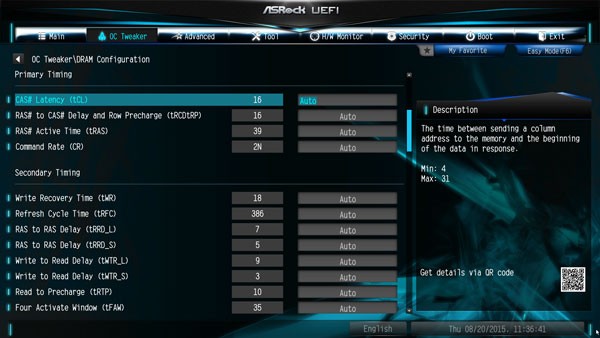
Furthermore, the ASRock Z170 offers more options for the memory in the DRAM Tweaker menu and an overview of all SPD and XMP memory values for direct selection.
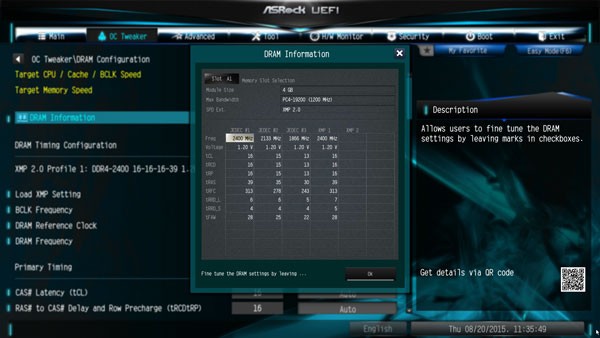
ASRock Z170 Extreme6 voltage settings …
Now we come to the various voltage values that can also be adjusted very extensive.
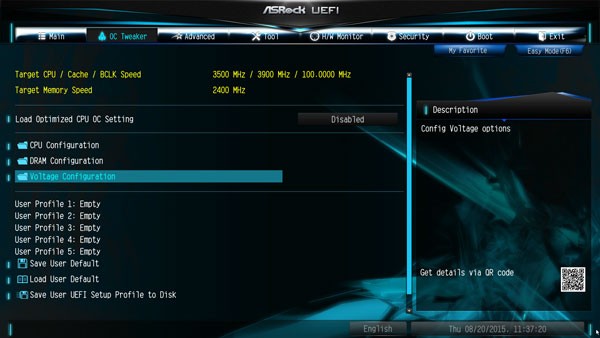
To offer the mainboard manufacturers a little more room for different motherboards, the voltage regulator (FIVR) were implemented externally on the motherboard and not anymore inside of the Intel Skylake CPU. Due to that the FIVR Configuration Menu is no longer available and we can proceed directly to the voltage configuration. Here you can see the values for voltage configuration:
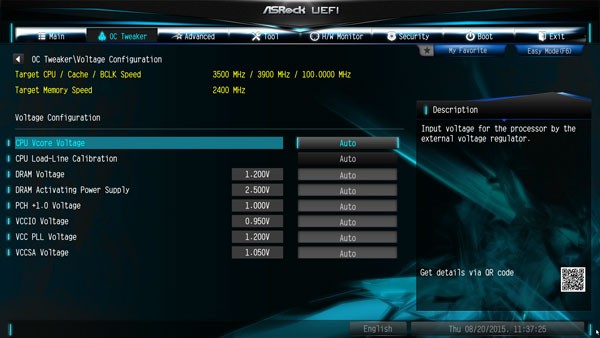
The motherboard has numerous voltage settings, such as the VCore with the Intel Core i5-6600K CPU Test from 0.900 to 1.520 volts (or offset), that could be somewhat higher for Extreme Overclockers, PCH +1.0 Voltage (chipset) from 0.900 to 1.300 volts, VCCIO Voltage from 0.850 to 1.500 volts, VCC PLL Voltage 1.100 to 1.500 volts, VCCSA Voltage (System Agent voltage) from 0.950 to 1.350 volts, Primary Plane Current Limit, Short Duration Power Limit, Long Duration Power Limit, CPU Load Line Calibration 1 to 4 and DRAM Activating Power Supply from 2.400 to 2.600 volts.
The DDR4 voltage can be set in the BIOS from 1.000 volts to 1.800 volts, so you can under- or overvolt the DDR4 modules strongly.
Overclock even easier …
If you do not want to get in touch with manual overclocking, you can try the so-called Load Optimized CPU OC Setting. There you can let the system overclock in different Turbo steps automatically – at least if the luck plays along and if it is possible with the components and the CPU. Simply select the desired increase and even some components with the Load Optimized CPU OC setting to a desired value, for example, Turbo 4.2 GHz, Turbo 4.4 GHz, Turbo 4.6 GHz or Turbo overclocked 4.8 GHz – overclocking could not be easier !
Here you can see the Load Optimized CPU OC Settings of the installed Intel 6600K CPU:
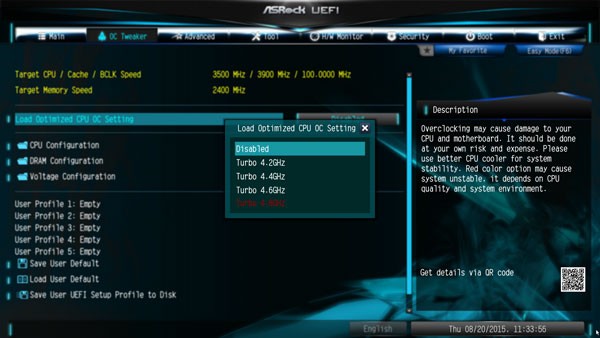
Higher overclocking rates you should better set manually, to meet the specifications better for each component. If you need help, please join our German and English PC Forum and we will be glad to help you.
If the correct settings are found, you can save up to five different BIOS settings with names in UEFI under the point OC Tweaker. There you can take, for example, a balanced BIOS settings, overclocking settings and undervolting values as user profile to load these values anytime again.
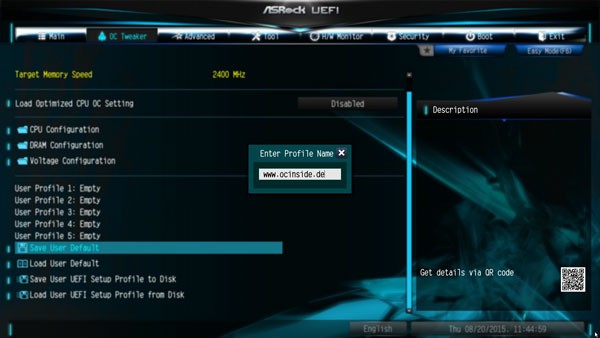
Of special interest is the “Save User UEFI Setup Profile to Disk” option. Just click and save your own UEFI settings on the hard drive or on an USB stick.
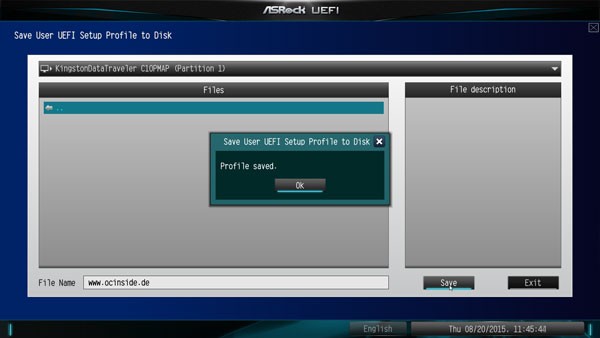
The Boot Failure Guard was also examined in the test and was able to boot the PC even after too high overclocking values without CMOS Clear. If the system however is not able to boot, you can use the Clear CMOS button. The stored values of the user profiles fortunately remain to load them quickly.
Tip:
If the PC due to strong overclocking does not start, it should do the job when you power off the PC power supply for about 10 seconds, wait until the motherboard LEDs go off, and then boot up again.
BIOS Undervolting …
The underclocking was also tested again in this review. To do this, the Intel Core i5-6600K CPU was set to the lowest multi 8x via the BIOS and could be underclocked thanks to new DMI / PCIe BCLK separation at 90 MHz BCLK to approximately 720 MHz. Underclocking is of course just like overclocking out of specification, so that in this case a bit of luck is always needed. ASRock provides at least the tools for the simplest possible Undervolting.
That are still not all UEFI settings, because there are the CPU, Chipset, Storage, Super IO, ACPI and USB Configuration to choose from.
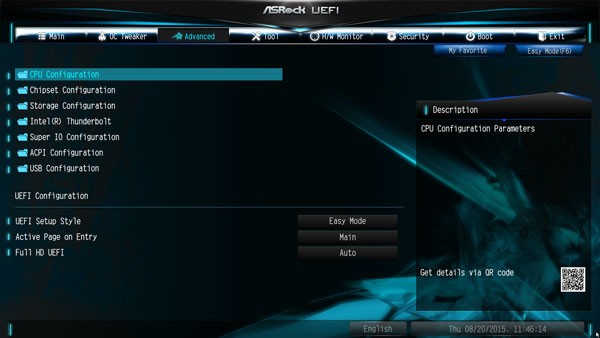
Tip:
A tip if the USB keyboard and/or USB mouse does not work in Windows 7, because no driver has been installed: ASRock provided under the point USB Configuration the PS/2 Simulator, which can easily be activated in this case, and afterwards you can use the keyboard and mouse in Windows.
Who wants to save power with Intel Core i5 PC, should also go through the settings necessarily in CPU Configuration menu in Advanced.
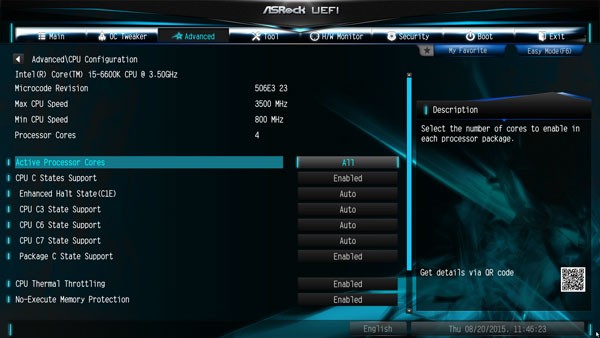
But the other settings, like the Advanced Chipset Configuration Menu are not unimportant as well.
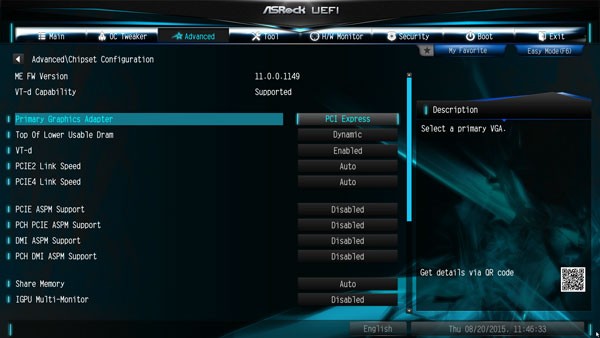
Fan control …
The UEFI setup of passively cooled Z170 Extreme6 motherboard has an extensive, temperature-controlled fan controller for the 4-pin CPU fan, CPU fan 1 and 2, as well as the 4-pin Chassis fans, Chassis fan 1 to 4.
The settings for the fan controller can be found in the H/W monitor directly below the extensive display of temperature and voltage values.
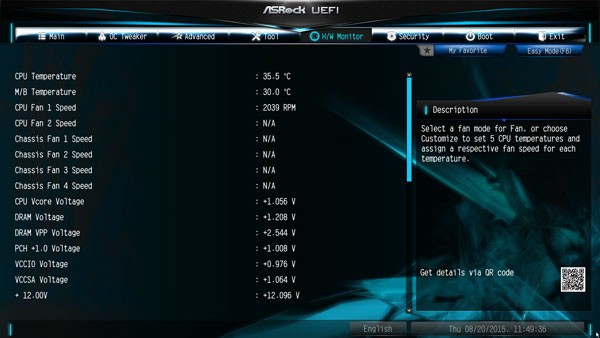
In the fan control you have the choice between Customize, Silent, Standard, Performance and Full Speed.
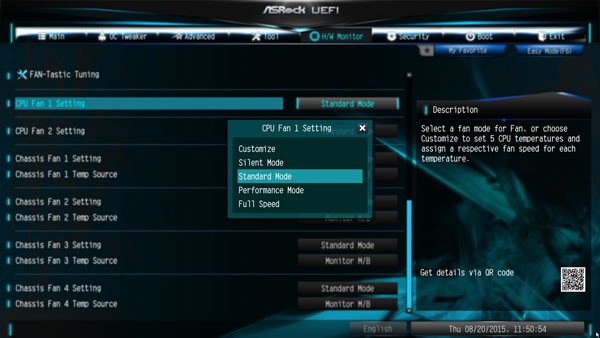
In Customize mode several temperature steps are available where you can assign a particular fan speed.
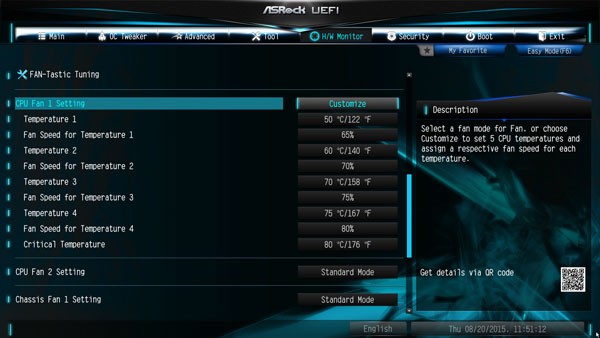
Because the fans are controlled with this fan control based on the CPU or the motherboard temperature, you can usually get along without an expensive fan control. BTW. the fan control can also be conveniently set via the supplied ASRock Tuning tool. First, you start the fan test to determine all possible rotation speeds, and then you can adjust the temperature curve as desired. The ASRock A-Tuning software offers many other tools, such as temperature monitoring and some OC settings OC Tweaker menu.
But that’s not enough, so ASRock has even implemented, as shown in the X99 Tests a graphical interface for controlling the fan in integrated UEFI setup. You can find the FAN-Tastic Tuning menu also in the H/W monitor and thus can make all the settings very clearly. Simply select on the left the respective fan connector and on the right side you can select the mode – e.g. Performance.
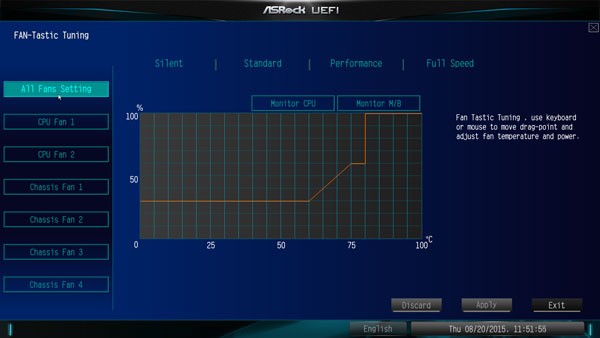
In Customize mode you can even set all the values directly in the chart and save them.
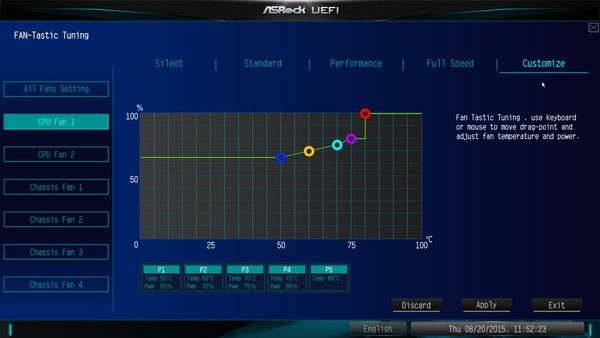
Regarding the Chassis Fan connectors you can select which source you want to use for temperature measurement: Monitor CPU sensor or monitor motherboard sensor.
Then just click Apply or exit the menu and save the values.
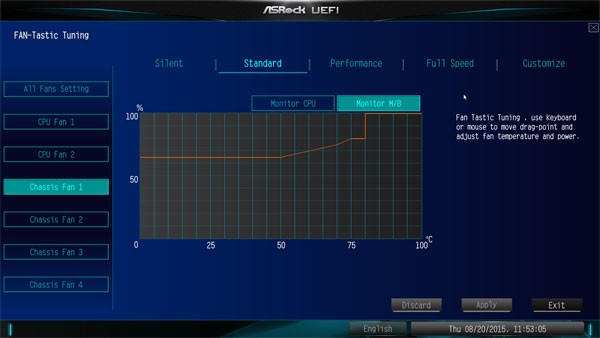
Energy consumption …
The PC power consumption will vary depending on hardware and PC load. The power consumption of the test PC with Intel Core i5-6600K LGA 1151 CPU, 4x 4GB DDR4-2400 memory, hard drive and Cooler Master Silent Pro M 600W PSU was without overclocking depending on the load at the following consumption:
– With MSI Radeon R9 280 graphics card was the entire Z170 PC Power Consumption 50.5W Idle and full load 256.1W.
– With integrated Intel HD Graphics GPU 530 the total consumption was 36.0W Idle and 70.7 watts at full load.
An ASRock X99 Extreme6 motherboard with an Intel Core i7-5930K CPU had the following power consumption:
– With MSI Radeon R9 280 between 60.5W idle and 290.4W load.
– With Sapphire HD6870 graphics card from 61.5W to 228.4 Watt full load.
An ASRock Z97 Extreme6 motherboard with an Intel Core i5-4670K CPU had the following power consumption:
– With MSI Radeon R9 280 between 53.1W idle and 270.7W load.
An ASRock Fatal1ty FM2A88X+ Killer motherboard with an AMD A10-7850K Kaveri APU had the following PC energy consumption:
– With Sapphire HD6870 between 56.3W idle and 233.5 Watt full load.
– With internal AMD Radeon R7 GPU between 30.2W idle and 118.8 Watt full load.
An ASRock FM2A85X-ITX motherboard with an AMD A10-5800K Trinity APU had the following power consumption:
– With Sapphire HD6870 graphics card from 52.9W to 221.0 Watts.
– With internal AMD Radeon HD7660D GPU 29.4W idle and 120.4 Watt full load.
ASRock Z170 Extreme 6 Result and general impression …

